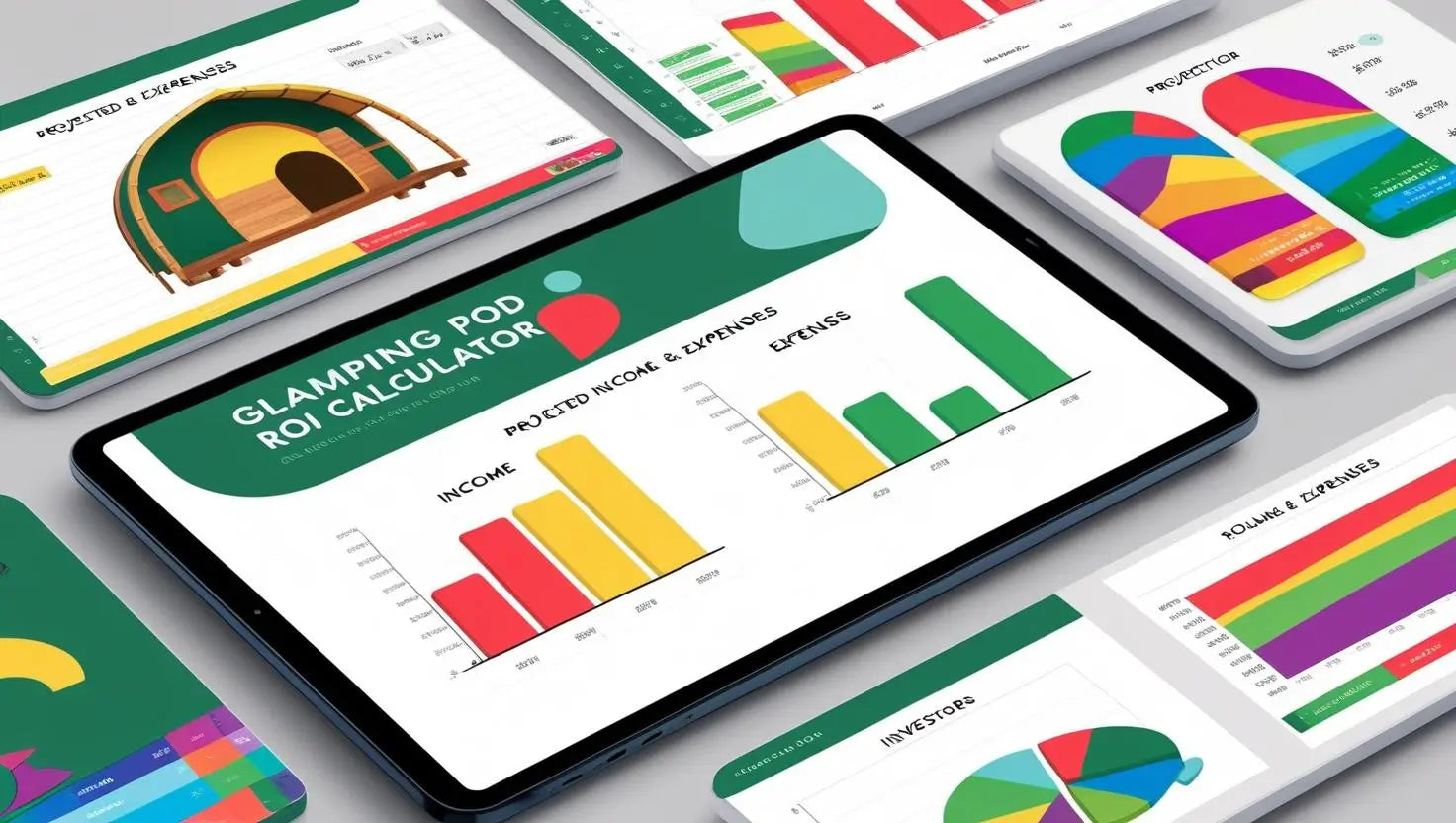Read Time: 10 mins
You might have heard of people ditching traditional houses and moving into tiny homes, shepherd huts, or glamping pods. One question often asked is: “Does it really cost less than renting?”
In 2025, UK private rents are still climbing. The Office for National Statistics reports that the average UK monthly private rent reached £1,344 in June 2025, up 6.7% year on year (ONS). That’s about £16,100 per year before utilities, council tax, or other bills.
In this blog, we take a realistic look at what it truly costs to live in a pod (using the XL Dual Halfmoon Pod as the example) versus continuing to rent. We include setup costs, monthly bills, hidden costs, and non-financial trade-offs, so you can decide if a pod is a viable alternative and how GlampLaunch can help if you choose that path.
The UK rental reality in 2025
• Average UK private rent in June 2025: £1,344/month (+6.7% YoY). (ONS)
• For new lets, Zoopla reports £1,301 in July 2025 (+2.4% YoY), showing easing inflation for new tenancies. (Zoopla)
• Regional variation matters. London advertised rents hit £2,712 pcm in Q2 2025, a record high, which can compress the payback period for ownership. (Rightmove)
Hidden costs in renting typically include:
• Security deposit (often 4–6 weeks’ rent), council tax, utilities (electricity, gas, water), internet/TV.
• Rising rent over time and restrictions (e.g., pets, modifications).
Illustrative baseline (2025):
• Rent: £1,344
• Energy/utilities: ~£140–£150/month
• Council tax + internet + other: ~£150/month
• Total: ~£1,634/month or ~£19,600/year (illustrative average outside London).

The XL Dual Halfmoon Pod and off-grid setup costs
To understand the real cost of pod living, we’ll use The XL Dual Halfmoon Pod, Luxury 4-Person Glamping Pod with Panoramic Window (RRP £34,995). It includes two bedrooms, a spacious living area, and a private ensuite bathroom. Built with weather-resistant materials and strong insulation, it can last 20+ years with proper maintenance. This is a long-term housing solution, not a temporary cabin.
Core setup components and estimated costs
| Item | Estimated cost (GBP) | Notes |
| XL Dual Halfmoon Pod | £34,995 | Includes ensuite, living space, two bedrooms |
| Foundation/base/site preparation | £2,000–£5,000 | Terrain and access dependent |
| Water supply or rainwater harvesting | £1,000–£2,000 | Storage + filtration |
| Solar, inverter, battery storage | £5,000–£10,000 | Medium off-grid system |
| Interior finishes/ upgrades | £1,000–£3,000 | Optional |
| Misc. (permits, delivery, connections) | £500–£2,000 | Site/distance dependent |
Total estimated setup cost: £45,000–£55,000. This covers everything needed for a comfortable, durable, fully functional off-grid home built to last decades.
Optional off-grid add-ons (for smaller pods without bathrooms)
• Eco-friendly portable outdoor shower cubicle – £2,495
• Eco-friendly portable outdoor dry composting toilet – £2,495
For example, The Arc En Ciel Pod – Large 2-Person Glamping Pod (RRP £10,995) plus shower and compost toilet creates a compact off-grid setup for ~£16,000–£20,000, depending on power/water choices.
Realistic baseline for comparison
For our cost comparison below, we model £48,000 as a realistic all-in figure for the XL Dual Halfmoon Pod, including essential off-grid systems and installation. That’s a ready-to-live setup that can last 20+ years, often for less than three years of average UK rent.

Monthly running costs: pod living vs renting
Once the setup is done, the ongoing savings begin. We compare a typical rented home to an off-grid (or semi-grid) pod.
Energy, heating and electricity
The Ofgem price cap implies a typical dual-fuel bill of £1,755/year (about £146/month) for Oct–Dec 2025, which we use as the renting energy baseline. (Ofgem)
An off-grid pod can cut this dramatically through solar + battery, efficient appliances, and small-space heating. Many owners keep a small generator or limited grid hookup for winter security.
• Modelled pod energy cost: £30–£80/month
• Conservative assumption for comparison: £50/month
Water, sewage and waste
• Typical rented home: ~£30–£60/month.
• Pod with rainwater harvesting/filtration and a composting toilet: ~£10–£20/month (filters, occasional maintenance).
Heating, insulation and climate control
Older UK homes often leak heat; pod footprints are smaller, and GlampLaunch pods are highly insulated. Expect ~£5–£20/month for supplementary heating (e.g., infrared panel or compact stove), depending on weather and usage.
Internet, insurance and upkeep
• Internet/mobile: £30–£50/month (both cases).
• Pod maintenance: ~£20–£40/month (sealants, servicing).
• Insurance (pod + contents): ~£5–£15/month.
Council tax and local charges
Most rented homes pay £100–£200/month in council tax. Off-grid pods vary by use and local classification; some setups face minimal or no ongoing local charges. Always check with your council.
Summary: monthly cost comparison (2025 estimates)
| Cost component | Renting (UK avg) | Pod living (off-grid) |
| Rent/mortgage | £1,344 | £0 (after setup) |
| Energy/electricity | £146 | £50 |
| Water/sewage | £40 | £15 |
| Heating/climate | included | £10 |
| Internet/mobile | £40 | £40 |
| Maintenance & insurance | included | £30 |
| Council tax / local charges | £120 | £0 (or minimal) |
| Estimated monthly total | ~£1,700 | ~£145- £200 |
What that means over a year
• Renting: ~£20,000
• Pod living: ~£1,800–£2,400
Even allowing for variations, off-grid living can be over 90% cheaper month-to-month once the setup is paid.

Break-even analysis: how many years until a pod pays for itself?
Assume an all-in setup of £48,000. From Section 3:
• Renting: ~£1,674–£1,700/month
• Pod running: ~£180/month
Monthly saving ≈ £1,494 → ~£17,900/year.
Break-even: £48,000 ÷ £17,900 ≈ 2.7 years.
If setup costs are lower (say £40,000) or your rent is higher (e.g., London £2,712 pcm), payback can drop to ~2–2.5 years. (Rightmove)
After five years, a typical renter may spend ~£100,000 with no assets; a pod owner has covered setup, spent ~£10k on utilities/upkeep, and still owns a dwelling that can last 20+ years.
Non-financial benefits and lifestyle trade-offs
• Ownership and asset. Renting payments vanish; a pod is a tangible asset that you control, with a long life when maintained.
• Freedom and control. You choose the layout, energy systems and (subject to permissions) location, no landlords, no rent hikes.
• Sustainability and self-sufficiency. Solar, rainwater harvesting and compost toilets reduce footprint and monthly outgoings while building resilience.
• Comfort and design quality. Modern pods are bright, well-insulated and efficient; compact living without compromise.
Considerations. Planning, land access and site logistics are real, but manageable. Compared with the stress of rising rents, these are one-off steps that lead to long-term independence. For planning guidance, see GlampLaunch’s UK glamping site planning permission guide. "Mastering Planning Permission: How to Get Your UK Glamping Site Approved".
Is pod living suitable for you?
Pod living suits people who value independence, sustainability and cost control. Before you leap, check:
• Land and permissions. Access to suitable land (owned/leased/family) with drainage and access; local council permissions depending on use and permanence.
• Use case. Garden annexe, income-generating stay, starter home, or creative retreat. Many owners run a hybrid: personal use + occasional letting.
• Financial and practical planning. Keep a buffer for maintenance or upgrades; ensure transportability if you may move; consider financing and repaying via rent savings or guest income.
Value retention, ROI and resale potential
A pod isn’t just somewhere to live, it’s an asset. Well-maintained, high-spec pods tend to retain meaningful value over time; condition, specification and brand reputation all matter. Using a pod for short-term stays can also generate income to offset initial costs. Over five years, the combined effects of rent avoided + low running costs + retained value create a profile that renting can’t match.
Five-year picture (illustrative):
• Renting: £1,674 × 60 ≈ £100,000 spent.
• Pod: ~£48,000 setup + ~£2,000/year upkeep + ~£180/month utilities ≈ ~£55,000 in five years, and you still own the pod.

Risks and sensitivity scenarios
All major decisions have risks, but these are typically smaller and more controllable than the uncertainty of renting:
| Risk | Possible impact | Mitigation |
| Over-ambitious solar sizing | Temporary generator/grid use raises costs | Design for realistic year-round loads; size for winter |
| Planning permission refusal | Restrictions on permanent occupancy | Research policy early; get expert help with applications |
| High site-prep costs | Setup budget overruns | Choose accessible, well-drained plots; get multiple quotes |
| Low letting demand | Slower ROI if relying on guest income | Research local demand; diversify use (retreats/long-term) |
| Wear and weathering | Maintenance costs over time | Choose weatherproof spec; schedule routine upkeep/warranty |
Run a worst-case (higher setup, lower income) to stress-test your plan. Even then, once the setup is paid, pod living is usually more affordable and secure than renting.
Conclusion
The numbers speak for themselves: pod living isn’t a trend, it’s a smarter, more sustainable way to live. Instead of paying rising rent for a space you’ll never own, you can invest once and gain lasting independence, lower monthly costs, and complete control over your home and lifestyle.
At GlampLaunch, we make that possible. Our team guides you from first idea to finished installation, handling design, planning, delivery, and support so you can focus on the end goal: a beautiful, efficient living space that’s truly yours. Whether you’re planning an off-grid retreat, an affordable home alternative, or a revenue-generating glamping setup, we’ll help you get there with confidence.
When you’re ready to explore what your own setup could look like, from realistic costs to site layout and planning options, we’re here to help.
Schedule your consultation with GlampLaunch, and our team will help you start designing your pod living plan today.
Summary
• UK rents continue to rise in 2025, averaging £1,344 per month (£16,100 per year), with total living costs often exceeding £19,000 annually once bills and taxes are added.
• The XL Dual Halfmoon Pod (£34,995) offers a long-term, high-quality living alternative, with total setup costs typically around £45,000–£55,000 for a complete off-grid home.
• Monthly running costs for pod living average just £145–£200, compared to roughly £1,700 for renting, saving over 90% each month once setup is paid.
• Break-even point: approximately 2.5–3 years, after which pod owners live nearly rent-free while renters continue paying rising costs.
• Pods deliver strong insulation, durability (20+ years), and flexibility for sustainable off-grid living through solar, rainwater harvesting, and compost systems.
• Non-financial advantages: ownership, design control, reduced environmental impact, and independence from landlords or rent inflation.
• Key considerations include land access, permissions, and installation logistics, which GlampLaunch supports with expert planning advice.
• Over five years, renters may spend ~£100,000 with no assets, while pod owners spend ~£55,000 total and retain a valuable dwelling.
• Risks such as planning refusal or higher setup costs can be mitigated through proper site assessment and professional guidance.
FAQs
1. Is living in a glamping pod cheaper than renting in the UK?
Yes, significantly. In 2025, the average UK rent is around £1,344 per month (ONS), or roughly £19,600 per year once utilities and council tax are included.
By contrast, once a GlampLaunch The XL Dual Halfmoon Pod, Luxury 4-Person Glamping Pod with Panoramic Window is fully set up (around £48,000 total), the monthly running costs average just £145–£200. That’s over 90% cheaper month-to-month after setup, with the pod fully owned and no rent payments.
2. How long does it take for a pod home to pay for itself?
Using 2025 figures, a pod costing £48,000 all-in breaks even in around 2.7 years compared to renting.
At typical rent levels (£1,700/month), you save roughly £17,900 per year, meaning that after less than three years, your investment has effectively paid for itself.
In higher-rent regions like London, the payback can drop to 2–2.5 years.
3. What are the ongoing monthly costs of pod living in the UK?
Pod running costs are very low because of off-grid efficiency and small space design.
Typical monthly estimates (2025):
• Energy & electricity: £30–£80/month (solar-powered)
• Water & waste: £10–£20/month (rainwater harvesting + compost toilet)
• Heating & upkeep: £20–£40/month
• Internet & insurance: £40–£60/month
That totals roughly £145–£200/month, versus over £1,600/month for an average rental home.
4. What setup costs are involved in living in a pod full-time?
A realistic all-in setup for The XL Dual Halfmoon Pod, Luxury 4-Person Glamping Pod with Panoramic Window ranges between £45,000 and £55,000, covering:
• The pod itself (£34,995)
• Foundations and site prep (£2,000–£5,000)
• Solar and power setup (£5,000–£10,000)
• Water storage and filtration (£1,000–£2,000)
• Delivery, installation, and permits (£500–£2,000)
This makes pod living a long-term housing solution with a lifespan of 20+ years, comparable to owning a small eco-home outright.
5. What are the main benefits and trade-offs of pod living vs renting?
Benefits:
• You own your home instead of paying rent.
• Monthly costs are minimal (no mortgage, no landlord).
• Eco-friendly design with solar, rainwater, and composting systems.
• Freedom to customise layout and location.
Trade-offs:
• Requires access to suitable land and, in some cases, planning permission.
• Higher upfront cost.
• Maintenance responsibility rests with you.
Despite these, most pod owners find that the long-term financial independence and sustainability far outweigh the initial effort and cost.





